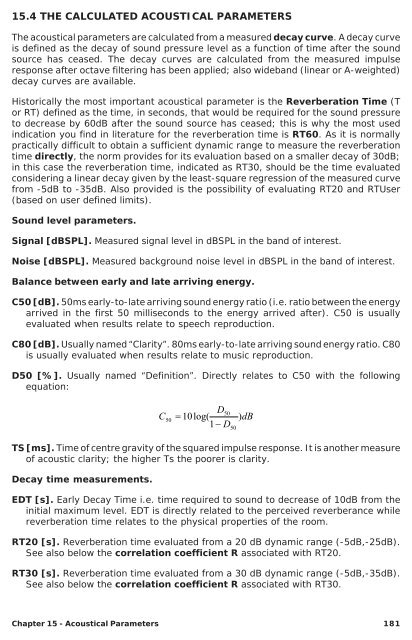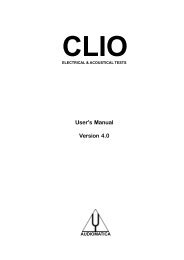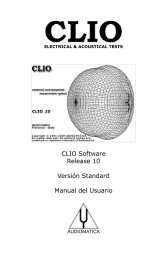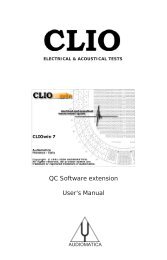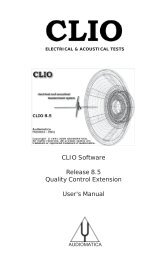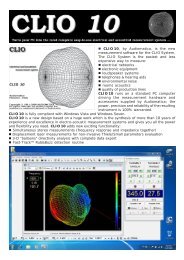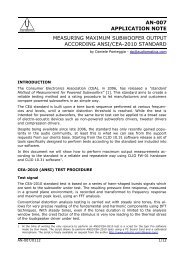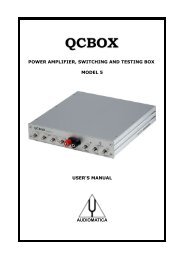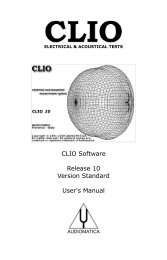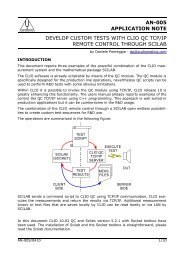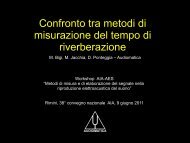CLIOwin 7 PCI User's Manual - Audiomatica
CLIOwin 7 PCI User's Manual - Audiomatica
CLIOwin 7 PCI User's Manual - Audiomatica
You also want an ePaper? Increase the reach of your titles
YUMPU automatically turns print PDFs into web optimized ePapers that Google loves.
15.4 THE CALCULATED ACOUSTICAL PARAMETERS<br />
The acoustical parameters are calculated from a measured decay curve. A decay curve<br />
is defined as the decay of sound pressure level as a function of time after the sound<br />
source has ceased. The decay curves are calculated from the measured impulse<br />
response after octave filtering has been applied; also wideband (linear or A-weighted)<br />
decay curves are available.<br />
Historically the most important acoustical parameter is the Reverberation Time (T<br />
or RT) defined as the time, in seconds, that would be required for the sound pressure<br />
to decrease by 60dB after the sound source has ceased; this is why the most used<br />
indication you find in literature for the reverberation time is RT60. As it is normally<br />
practically difficult to obtain a sufficient dynamic range to measure the reverberation<br />
time directly, the norm provides for its evaluation based on a smaller decay of 30dB;<br />
in this case the reverberation time, indicated as RT30, should be the time evaluated<br />
considering a linear decay given by the least-square regression of the measured curve<br />
from -5dB to -35dB. Also provided is the possibility of evaluating RT20 and RTUser<br />
(based on user defined limits).<br />
Sound level parameters.<br />
Signal [dBSPL]. Measured signal level in dBSPL in the band of interest.<br />
Noise [dBSPL]. Measured background noise level in dBSPL in the band of interest.<br />
Balance between early and late arriving energy.<br />
C50 [dB]. 50ms early-to-late arriving sound energy ratio (i.e. ratio between the energy<br />
arrived in the first 50 milliseconds to the energy arrived after). C50 is usually<br />
evaluated when results relate to speech reproduction.<br />
C80 [dB]. Usually named “Clarity”. 80ms early-to-late arriving sound energy ratio. C80<br />
is usually evaluated when results relate to music reproduction.<br />
D50 [%]. Usually named “Definition”. Directly relates to C50 with the following<br />
equation:<br />
D50<br />
C<br />
50<br />
= 10log( ) dB<br />
1−<br />
D<br />
TS [ms]. Time of centre gravity of the squared impulse response. It is another measure<br />
of acoustic clarity; the higher Ts the poorer is clarity.<br />
Decay time measurements.<br />
EDT [s]. Early Decay Time i.e. time required to sound to decrease of 10dB from the<br />
initial maximum level. EDT is directly related to the perceived reverberance while<br />
reverberation time relates to the physical properties of the room.<br />
RT20 [s]. Reverberation time evaluated from a 20 dB dynamic range (-5dB,-25dB).<br />
See also below the correlation coefficient R associated with RT20.<br />
RT30 [s]. Reverberation time evaluated from a 30 dB dynamic range (-5dB,-35dB).<br />
See also below the correlation coefficient R associated with RT30.<br />
50<br />
Chapter 15 - Acoustical Parameters 181


